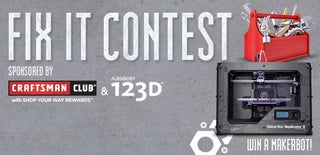Introduction: Restoring a Vintage Hand Plane
I absolutely love these tools. Their design has been virtually unchanged for over a hundred years now. They're aesthetically pleasing, ergonomic, long lasting, and exceptionally good at what they do. All around, it's an amazing tool. So, how could i pass up the opportunity to restore one of these to their original glory?!
It's a pretty simple procedure that anyone can get into with very few tools/equip. Keep in mind that with any tool restoration, you get out of it exactly what you put into it. If you like the look of semi-oxidized metal then you don't have to buff it to a mirror shine; you can make the tool look as "antique" or as new as you want.
*YOU WILL BE USING VARIOUS CHEMICALS DURING THE RESTORATION PROCESS, SO PLEASE MAKE SURE TO FOLLOW ALL OF THE SAFETY PROCEDURES FOUND ON THE PRODUCTS*
WHAT YOU'LL NEED:
materias
- scotch brite pads
- wd-40
- steel wool
- various grits of sandpaper (i went as low as 100 and as high as 2000 wet/dry)
- evapo rust or krud kutter (you can find this stuff at any lowes/home depot for about $10 a bottle)
- plenty of rags/paper towels
- machine oil
- boiled linseed oil
- buffing compound (i think i used mother's brand compound i bought at auto zone)
- screwdrivers
- drill press would be ideal, but if not a hand held drill works fine (that's all i had)
- all the elbow grease you can muster
Step 1: Assessing the Damage
Before you delve into anything it's good to know what you're up against. It's a good idea to inspect the tool before you buy it...check for any cracks and gouges; loose, missing, replaced or ill fitting pieces, and deep pockets of rust. Surface rust no matter how bad, can be cleaned off, but if a part is rusted through then you're in trouble. If possible, try to identify the piece you're looking at to give you an idea of its age and worth. If it's a stanley plane you can use this chart to identify it.
Once you've got the tool, take it apart carefully (you don't want to strip any screwheads or crack any wood). Make sure the screw threads are in good shape, and that the wood is in tact.
Step 2: Time to De-rustify!
- soaking rusted parts in apple cider vinegar
- using a chemical remover like naval jelly, evapo rust, or krud kutter (this is what i used)
- electrolysis
- wd-40 and scotch brite and steel wool (i used this technique as well, but it's hard to do on rounded or small parts)
After the chemical bath, i dried the pieces, and gave them a quick scrub with wd-40 and steel wool to clean off any leftover bits and pieces.
To soak the frog and the plane i just a gallon sized ziploc bag to accommodate for the size of the pieces
Step 3: De-rustification Part Duex
While the smaller pieces are soaking i tried out the wd-40 + scotch brite pad method on the larger flat pieces (i.e. plane iron and chip breaker). This method works wonders in a really short time since i can really put some pressure on the pieces.
Step 4: Getting a Handle on Things
After you clean up your metal parts, you can move on to the handle (aka tote) and knob. Simply take some sand paper (100 or 120 grit) and have at it! The tote is a little tricky because of all the curves and angles, but just be patient...the old finish comes off pretty quick. Once you've got the finish off you can progress to 220. I finished with about 320, but feel free to go higher (anything above 600 grit is overkill though).
For the knob, i took a thin dowel, wrapped some tape around it until it was nice and snug in the hole for the screw and chucked the other end into my drill and voila! A mini lathe. This makes sanding the knob a breeze....just be sure to wear a dust mask (that stuff will get everywhere and you don't that in your lungs).
Now that you've sanded them down to a buttery smooth finish you can apply the oil. There are a few different finishes you can apply, or combine such as danish oil, tung oil, or shellac. I tried to avoid using any kind of varnish like polyurethane because it leaves the wood with a "plastic" look and feel, where as the oils tend to pop the grain and keep the wood feeling soft. This is great if you intend to use the tool...if you just want to display it, then a varnish, or oil-varnish blend might be the way to go.
Step 5: Make It Shiny!
So now your parts have been de-rusted and cleaned...but they still look a bit dull. An easy way to fix that is with some wet/dry sand paper, a rag, and some buffing compound. This video from Mrballeng is basically what i did to get all of my screw heads nice and shiny.
I just wrapped some paper towel around the screws to protect the threads, chucked it into my drill and polished away! The lever cap was a bit tough because i had to polish it by hand. But i went through the same process as the video in the same order. I suppose if you have abrasive wheels or pads you can use your drill to to the polishing...next time i guess.
*Side note: many planes (like the one on the left in step one) have brass components. As you may or may not know, brass does not rust! So, you don't have to treat it chemically, you can actually skip right to this step after a light cleaning.
Step 6: Flat and Sharp
If, however you plan on putting this guy to use, then you're gonna need to lap both the back of the plane iron and the bottom of the plane bed. As this isn't a tutorial on sharpening hand tools (i could do an entire instructables on it), I won't go into too much detail for this. Basically you glue varying grits (roughly 80, 120, 220, 400) of sandpaper to a flat surface (plate glass, or piece of granite, etc) and run the plane bed over it repeatedly until you get an even scratch pattern. Make sure to check for square by putting a straight edge across the bottom and holding it up to a light source. If you see light peeking through you've got more flattening to do. If not, you're all set!
For the plane iron, you could use the same set up, but you're gonna need a set of water stones at much higher grits (1000, 4000, 8000) to really put a shaving sharp edge on it. First lap the back of the iron through all the grits to get it nice and flat. Then flip it over, put it into a honing guide set at your desired angle (typically between 25-30 degrees), and once again run your gambit of grits. To get that razor sharp micro bevel at the end, simply run your iron across the 8000 grit about ten times at a slightly higher angle than normal.
You should also smooth out the point of contact between the chip breaker and the plane iron, to reduce any possible chatter.
If you're interested in doing your own sharpening, this was my setup:
if you have any questions on this step feel free to leave questions in the comments or just email me. I'd be happy help!
Step 7: Step Back and Admire!
Now that you've put all that hard work into it, it's time to reassemble your masterpiece! Give it one last cleaning with a rag and a light coat of machine oil, and carefully put it back together!
Just like that you have a truly vintage tool ready for another 65 years of service.

Second Prize in the
Fix It Contest

Participated in the
Vintage Contest

Participated in the
Epilog Challenge V













